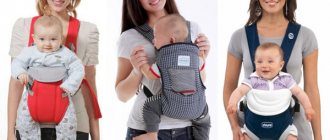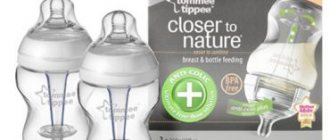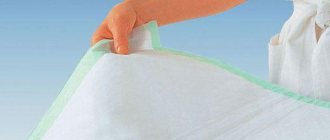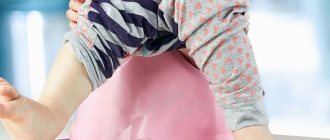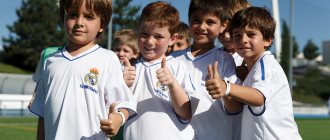It would seem that just recently your baby couldn’t even walk. And now he is stamping his feet, exploring the world around him with the tirelessness and courage characteristic of all children. You no longer need to support the baby so that he does not fall. But with the toddler’s new skill – walking – the problem of choosing the right shoes for him is very closely related. It turns out that this issue needs to be approached very, very seriously. After all, until the age of 6 years, the baby’s foot is not yet formed - cartilage tissue predominates in it. And proper selection of shoes at this age is very important for the development of the child’s feet and legs.
About the right shoes for children: how to choose and what to pay attention to
Incorrectly chosen shoes not only cause discomfort, but also increase the load on the spine and contribute to the curvature of the foot. And in childhood, this effect is even more dangerous - it can lead to flat feet, scoliosis and other health problems. That is why it is important to give preference to those models that meet the following criteria:
- have insoles made of environmentally friendly materials;
- are distinguished by a rigid fixing back;
- made of breathable materials.
On the modern domestic market there are many manufacturers specializing in the production of high-quality products that meet all criteria.
How to measure your foot correctly
Below are step-by-step instructions on how to measure the soles of children's feet:
- Place the baby on a clean piece of paper, making sure that the leg fits snugly to the surface of the paper.
- Circle it around the perimeter with a pencil.
- Measure the length from the extreme point of the heel to the big toe.
The result obtained is the size in centimeter equivalent.
Table: how to choose a child’s shoe size for the winter
Below is a universal grid
| Centimeters | 8,3 | 8,9 | 9,2 | 9,5 | 10,2 | 10,5 | 10,8 | 11,4 | 11,7 | 12,1 |
| USA | 0,5 | 1 | 1,5 | 2 | 2,5 | 3 | 3,5 | 4 | 4,5 | 5 |
| Great Britain | 0 | 0,5 | 1 | 1 | 1,5 | 2 | 2,5 | 3 | 3,5 | 4 |
| Europe | 16 | 16 | 17 | 17 | 18 | 18 | 19 | 19 | 20 | 20 |
| 1 - 1.5 years | 2 years | 3 years | 4 years | 5 years | 6 years | ||||||||||||
| Centimeters | 12,7 | 13 | 13 | 13,3 | 14 | 14,6 | 15,2 | 15,6 | 15,9 | 16,5 | 16,8 | 17,1 | 17,8 | 18,1 | 18,4 | 19,1 | 19,4 |
| USA | 5,5 | 6 | 6,5 | 7 | 7,5 | 8 | 8,5 | 9 | 9,5 | 10,5 | 10,5 | 11 | 11,5 | 12 | 12,5 | 13 | 13,5 |
| Great Britain | 4,5 | 5 | 5,5 | 6 | 6,5 | 7 | 7,5 | 8 | 8,5 | 9,5 | 9,5 | 10,5 | 10,5 | 11 | 11,5 | 12 | 12,5 |
| Europe | 21 | 22 | 22 | 23 | 23 | 24 | 25 | 35 | 26 | 27 | 27 | 28 | 29 | 30 | 30 | 31 | 31 |
| 7 years | 8 years | 9 years | 10 years | ||||||||||
| Centimeters | 19,7 | 20,3 | 20,6 | 21 | 21,6 | 21,9 | 22,2 | 22,9 | 23,2 | 23,5 | 24,1 | 24,4 | 24,8 |
| USA | 1 | 1,5 | 2 | 2,5 | 3 | 3,5 | 4 | 4,5 | 5 | 5,5 | 6 | 6,5 | 7 |
| Great Britain | 13 | 14 | 1 | 1,5 | 2 | 2,5 | 3 | 3,5 | 4 | 4,5 | 5 | 5,5 | 6 |
| Europe | 32 | 33 | 33 | 34 | 34 | 35 | 36 | 36 | 37 | 37 | 38 | 37 | 39 |
Choosing a size
Size is the most important parameter when choosing children's shoes for the winter. If it is chosen for growth, it will most likely dangle. It is uncomfortable for a baby to walk in large shoes; he often trips and falls. When walking in tight boots, boots or felt boots, blood circulation is disrupted, which leads to hypothermia of the feet. Since the foot is strongly compressed in tight shoes, this disrupts the process of its formation and often causes flat feet. In order for the ankle joint and spine to develop correctly, the shoe size should be 1-1.5 cm larger than the length of the foot. This reserve is enough for normal air circulation, high-quality thermal insulation, and foot comfort.
To measure the length of a child's foot, follow the following algorithm:
1. Ask him to stand on a white sheet of paper or cardboard spread on a flat surface.
2. Holding a pencil or pen strictly vertically, trace his foot.
3. Cut out the resulting outline and measure it with a ruler.
The left and right legs must be measured separately as they may vary slightly in length. If one foot is longer than the other, you need to use a larger measurement.
With this outline you can go to shoe stores. It is enough to insert it into the boot or shoe you like to understand whether it matches the size of the child’s feet. If there is a gap of more than 1.5 cm inside between the insole and the walls, then the shoes are too big. If the cut out outline is bent or wrinkled after trying it on, it means it is big.
You can determine the foot size of a baby who has not yet begun to stand or walk using a rope. To do this, measure the distance from the top of your longest toe to the end of your heel. The resulting segment must be transferred to a ruler and added 1-1.5 cm to it.
How quickly does a child's leg grow?
The most active growth rates are observed in childhood. So, in the period from 2 to 5 years, the feet lengthen by a couple of centimeters every year. That is why it is recommended to measure them at least once every four months.
Important advice! Up to five years, it is not necessary to buy an expensive option, since it will still have to be changed every three to four months. The proper model is the one in which the baby is comfortable and comfortable.
How to order winter membrane shoes for girls on Aliexpress?
Membrane shoes have recently become very popular. If earlier mothers bought membrane shoes for their babies, now they buy such shoes for themselves. These boots look like ordinary shoes, but between the sole and the insole a material made of a special polymer with a fine-porous structure is glued.
Advantages of membrane shoes:
- Doesn't get wet . Thanks to the membrane, moisture does not get inside the shoe, since the pores of the layer are smaller than a water molecule.
- The leg does not sweat and breathes. The pore size of the membrane is larger than a molecule of water vapor, so the leg breathes.
- Retains heat well. The membrane has low thermal conductivity and retains heat for a long time.
order winter shoes for girls membrane on Aliexpress
How to choose winter shoes for a child: three important factors
When sewing children's shoes, manufacturers, as a rule, are guided by hygienic and medical indications. In this case, parents should pay attention to three fundamental criteria:
- Length – boots must be the right size, otherwise it may cause crooked toes or flat feet.
- Fullness - in a cramped position, the legs freeze faster, which negatively affects the health of children.
- The rise is what determines the convenience of the model.
Taking these factors into account allows you to choose the most comfortable option.
Winter shoes for children: boots and boots
In our catalog, winter shoes for children are represented by the brands Nordman, M+D, Tom-Miki, Tom.m, M-michi. Select sort by season to see all available models. We indicate the sizes that are in stock and recommend checking the table to avoid mistakes.
Almost all shoes for girls and boys for the winter season have very practical non-slip soles. It is made of thermoplastic rubber, polyurethane. In the cold, these materials will not harden or crack. These shoes are designed for many years of use.
Many models of winter children's boots are reinforced with membrane upper fabric - it does not allow wind, cold and moisture to pass through. Insulation materials are made from natural wool or wool mixture. If a very cold winter is expected, and you like long forest walks with the whole family, choose strong insulation. And for school and walks at the beginning and end of winter, a lighter option is suitable.
Unlike autumn models, insulated children's shoes in online stores are intended mainly for outdoor use. Take this into account and be sure to give your child a shift with you to school. Sitting in class in warm boots is torture.
Choosing shoes according to age
Next, we present to your attention three size tables for different ages.
How to choose winter shoes for a child aged 1, 2 and 3 years
| Foot length, up to (cm) | 9,5 | 10,5 | 11 | 10,6 | 12,3 | 13 | 13,7 | 14,3 |
| Children's shoe size (minimum) | 16 | 17 | 18 | 19 | 20 | 21 | 22 | 23 |
| Foot length, up to (cm) | 14,5 | 15,5 | 16,2 | 16,8 | 17,4 | 18,1 | 18,7 | 19,4 |
| Children's shoe size (minimum) | 24 | 25 | 26 | 27 | 28 | 29 | 30 | 31 |
| Foot length, up to (cm) | 20,1 | 20,7 | 21,4 | 22,1 | 22,7 | 23,4 | 24,1 | 25,7 |
| Children's shoe size (minimum) | 16 | 17 | 18 | 19 | 20 | 21 | 22 | 23 |
Solution: buy children's shoes inexpensively in the Sarita online store
Students can be difficult to please. They already have their own taste and understanding of beauty, which may differ from your ideas. It's not very pleasant to buy shoes that fit perfectly and receive dissatisfied emotions from a teenager in return.
Don't force your own style on your children - let them experiment! We recommend choosing shoes for girls and boys together with children after reaching the age of 10. Open the catalog and show the children all the options. The advantage of buying online is that you have a lot of time to choose. Consider all the models in detail, think about what clothes you can wear the new boots with. Consult with your child, tell him about the pros and cons of different models. This way you will teach him to independently weigh the pros and cons in order to make the right choice.
At the same time, do not forget that winter children's boots and boots serve not only to protect against the cold, but also as an element of style. Today this is very relevant, so brands try to offer many variations of shoes every new season. Listen to what your child wants and let him decide how the new boots will visually look.
In our catalog, the cost of winter shoes starts from 1,785 rubles. Please note: we regularly run promotions so you can buy everything you need. When it comes to clothes and winter shoes for a child, there should be no compromises!
How to choose the right children's winter shoes
To choose the right boots for your baby, you need to take into account a number of criteria. Firstly, what they are made of. Secondly, what is used as insulation. Also, you need to pay attention to the seasonal framework - winter or autumn-spring.
Below, more details about each of the indicators.
Materials
Children's winter shoes should be made exclusively from natural, high-quality materials. The best option is insulated leather boots with inner fur. They will not only warm the child’s feet well, but will also protect them from getting wet. In addition, real leather does not crack from frost.
According to the current legislation of the Russian Federation, the product must be made from environmentally friendly and hypoallergenic materials.
Insulation
Natural sheepskin is most often used as insulation material. Possessing high thermal insulation properties, it protects the feet from hypothermia.
If you live in a warm climate that doesn't experience harsh winters, you may want to consider faux fur. It will not create a greenhouse effect, while retaining heat.
Primary requirements
Another important selection criterion is the quality of the insoles and soles. They should be quite plastic and springy, creating a shock-absorbing effect, since this is the only way to minimize pressure on the spine and ensure comfort when walking.
Polyurethane is most often used in the manufacture of soles. However, it is absolutely not suitable for children's shoes. It is replaced by more elastic thermoplastic elastomer and polyvinyl chloride.
Main selection criteria
Summarizing all of the above, we can list the key selection criteria.
- Convenience.
- Practicality.
- Only natural and hypoallergenic materials in the composition.
- Ease.
- Breathable structure that does not impede air circulation.
- Moisture resistant.
- Rough outsole that prevents slipping.
It is also recommended to select low-maintenance models.
Demi-season options
Autumn and spring are seasons characterized by high humidity and large amounts of precipitation. During this time, it is especially important to keep children's feet warm and dry. What models will cope with this task?
- waterproof boots with high tops;
- water-repellent boots made of genuine leather or suede;
- insulated rubber boots.
Orthopedists recommend taking a closer look at options with membrane insoles.
Winter options
The picture below shows the most comfortable and convenient models for winter.
Reviews from parents about different models of winter shoes
We present to your attention a selection of real reviews about different models from experienced parents. We hope they will help you find the best winter option.
“Year after year we buy leather boots with sheepskin trim - my daughter not only looks like a princess in them, but also doesn’t freeze even during long walks!”
“We always buy snowmobile boots with natural fur for our tomboy. It’s comfortable to run in them, and your feet are always warm!”
“In my opinion, the best option is water-repellent overshoes. Your feet will never get wet in these, and it’s comfortable to walk. They don’t look very good, but for special occasions you can pick up another pair!”
Summer options
We also attach a collage with the most successful summer models.
Signs of ill-fitting shoes
If after a walk the child’s feet are cold, the toes are red, and red furrows or calluses appear on the skin, it means that the boots are not the right size. It is difficult for the baby to move his fingers in them, which impairs blood circulation and leads to hypothermia.
If parents manage to wear several pairs of woolen socks under their shoes for a walk, it means they also made a mistake with the size. Boots or shoes that are too large will compromise their thermal insulation properties. Therefore, even wearing several socks, the child will feel cold. The same goes for a boot that is too loose, as it leaves gaps through which cold air and moisture can penetrate.
Shoes for the winter should provide warmth without the help of numerous woolen socks. In countries with a temperate warm climate, wrapped feet quickly sweat and begin to freeze. In this regard, membrane boots and shoes are preferable. To keep your feet warm, just wear synthetic tights or socks. It is not advisable to wear 100% cotton products because they absorb moisture and cool your feet.
Photo gallery: what shoes are best for a child to choose for the winter
Below is a more extensive selection of models by season for boys and girls.
Summer options for girls:
Summer options for boys:
Autumn-winter options:
You can purchase high-quality models at attractive prices on the website of the First Moscow Customs Goods Store.
What is the warmest shoes for a child to choose for winter for kindergarten and for physical education?
Most parents mistakenly assume that for classes in indoor spaces (dance classes, gyms, etc.) open models are needed - slippers, shoes or Czech shoes. In fact, sandals with orthopedic insoles are a better option. Being moderately comfortable and convenient, they allow the child to move calmly without experiencing discomfort.
As for sports lessons, standard running shoes will do. However, orthopedists do not recommend wearing them for more than two hours a day.
How to order winter children's shoes on sale on Aliexpress?
Aliexpress often has sales and it doesn't have to be Black Friday or November 11th. In fact, there are a lot of holidays in China when they have sales. Subscribe to updates and receive great offers directly to your email. On holidays it is possible to purchase goods with a 50% discount.
order winter children's shoes on sale on Aliexpress
If there are pathologies: what shoes for children are better for the winter?
Useful tips and recommendations for selecting products for children with orthopedic pathologies:
- Varus deformity: support on the outer sides of the feet, O-shaped bend of the knees. Orthopedists advise buying preventive options with hard backs and without arch supports.
- Valgus distortion: support on the internal arches, X-shaped placement of the knees. Orthopedic models with properly flexible soles are suitable.
If there are serious problems, consultation with a specialist is required before purchasing.


